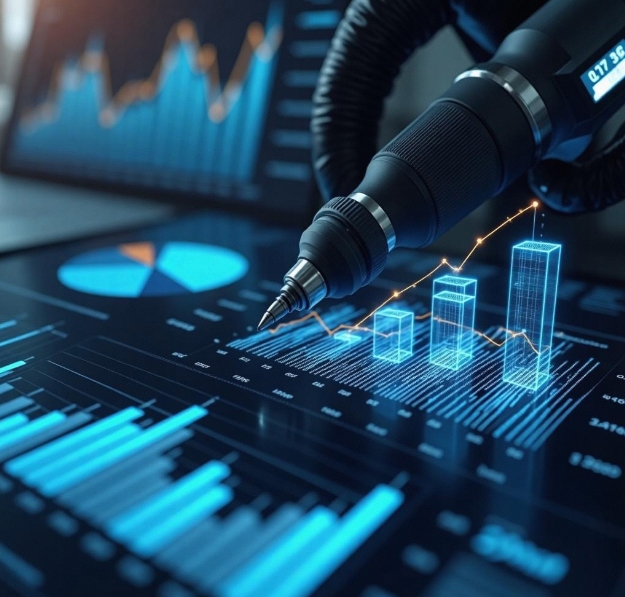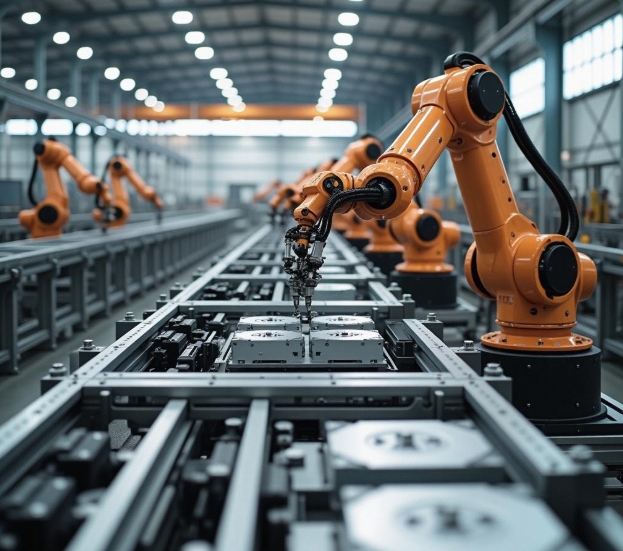Artificial Intelligence and Robotics: The Future of Intelligent Production
- latest articles
- 1.DApp Development & Customization: Merging Diverse Market Needs with User Experience 2.Analysis of the Core Technical System in DApp Project Development 3.How to achieve cross-chain interoperability in Web3 projects? 4.How does the tokenization of points reconstruct the e-commerce ecosystem? 5.How to Set and Track Data Metrics for a Points Mall? 6.What is DApp Development? Core Concepts and Technical Analysis 7.Inventory of commonly used Web3 development tools and usage tips 8.Development of a Distribution System Integrated with Social E-commerce 9.Six Key Steps for Businesses to Build a Points Mall System 10.What is DApp Development? A Comprehensive Guide from Concept to Implementation
- Popular Articles
- 1.Future Trends and Technology Predictions for APP Development in 2025 2.Analysis of the DeFi Ecosystem: How Developers Can Participate in Decentralized Finance Innovation 3.From Zero to One: How PI Mall Revolutionizes the Traditional E-commerce Model 4.DAPP Development | Best Practices for Professional Customization and Rapid Launch 5.Recommended by the Web3 developer community: the most noteworthy forums and resources 6.From Cloud Computing to Computing Power Leasing: Building a Flexible and Scalable Computing Resource Platform 7.How to Develop a Successful Douyin Mini Program: Technical Architecture and Best Practices 8.Shared Bike System APP: The Convenient Choice in the Era of Smart Travel 9.How to Create a Successful Dating App: From Needs Analysis to User Experience Design 10.From Design to Development: The Complete Process of Bringing an APP Idea to Life
In today's rapidly advancing technological landscape, the integration of artificial intelligence (AI) and robotics is progressively transforming global production methods. Intelligent manufacturing not only enhances the efficiency and precision of the manufacturing industry but also drives changes in industrial structure. From smart factories to autonomous robots, they are reshaping traditional industrial models at an unimaginable pace. This article will delve into how AI and robotics play a crucial role in the production sector and explore their future development directions.
I. The Background of AI and Robotics Integration
1.1 The Development History of Artificial Intelligence
The concept of artificial intelligence originated in the 1950s. With continuous advancements in computer technology, AI gradually transitioned from academic research to practical applications. In recent years, breakthroughs in deep learning, machine learning, and natural language processing have enabled AI to achieve remarkable success in fields such as image recognition, speech recognition, and data analysis.
1.2 The Evolution of Robotics
Robotics has also undergone significant development. From initial simple mechanical arms to modern intelligent robots, industrial robots are now capable of performing high-precision, highly repetitive tasks and are widely used across various stages of production lines. Traditional robots typically relied on pre-set programs to execute fixed tasks, but with the introduction of AI technology, robots can now perform more complex operations and make autonomous decisions, adapting to ever-changing production environments.
1.3 The Collaborative Development of AI and Robotics
The integration of artificial intelligence and robotics has brought unprecedented innovation to modern production. This synergy not only enhances production efficiency but also provides robust technical support for intelligent manufacturing. Robots can utilize AI for autonomous learning and self-optimization, making production processes more flexible and efficient.
II. Key Technologies in Intelligent Manufacturing
2.1 Machine Vision and Image Recognition
In modern intelligent manufacturing, machine vision systems are one of the core technologies enabling automation and precision production. By integrating AI algorithms, robots can "see" objects in the production environment and perform corresponding operations based on image analysis. Whether for quality inspection, material handling, or assembly operations, machine vision significantly enhances efficiency and accuracy.
2.2 Autonomous Decision-Making and Machine Learning
As a crucial branch of artificial intelligence, machine learning enables robots to autonomously learn by analyzing vast amounts of data and optimize production processes. In industrial production, robots can optimize production plans, adjust production line configurations based on real-time data analysis, and even make the most appropriate responses in unexpected situations.
For example, in automobile manufacturing, robots can adjust welding angles and intensity according to the specific requirements of each car body, ensuring precision and quality for every vehicle.
2.3 Cloud Computing and the Internet of Things
The combination of cloud computing and the Internet of Things (IoT) facilitates remote monitoring and data sharing in intelligent manufacturing. By uploading data from various production stages to the cloud, factory managers can monitor key information such as production status and equipment health in real time, thereby optimizing production processes and resource allocation.
IoT technology enables seamless integration between robots and other equipment on the production line, creating an intelligent, interconnected production environment that reduces human intervention and improves production efficiency and quality.
III. Applications of AI and Robotics in Intelligent Manufacturing
3.1 Smart Manufacturing
Smart manufacturing refers to the application of technologies such as artificial intelligence, robotics, cloud computing, and big data in traditional manufacturing to make production processes more intelligent, automated, and flexible. Smart manufacturing enhances production efficiency, reduces costs, and better meets the demands of personalized customization.
For instance, some automobile manufacturers have adopted automated production lines that extensively use robots for tasks such as assembly, welding, and painting. These robots, through real-time data feedback and AI analysis, can autonomously adjust their operational paths, ensuring efficiency while minimizing human intervention and errors.
3.2 Unmanned Warehousing and Logistics
The application of artificial intelligence and robotics in the logistics sector is also transforming traditional warehousing and distribution models. Unmanned warehousing systems use robots for automated material handling and sorting, while AI algorithms provide precise inventory predictions, reducing labor costs and improving warehouse operational efficiency. With the widespread adoption of 5G networks, these systems will achieve more efficient real-time scheduling and finer management.
3.3 Intelligent Inspection and Quality Control
Quality control is a critical aspect of manufacturing. Traditional quality inspections often rely on manual checks, which are time-consuming and prone to errors. By incorporating AI and robotics, production lines can perform real-time quality inspections. Machine vision systems can automatically identify defects during the production process, ensuring that every product meets quality standards. This technology is widely used in industries such as electronics, food, and pharmaceuticals.
3.4 Customized Production and Flexible Manufacturing
With the diversification of consumer demands, traditional assembly line production methods can no longer meet the requirements for customization and flexible manufacturing. AI and robotics enable production lines to make flexible adjustments and quickly adapt to the production needs of different products. In sectors such as apparel, footwear, and electronics, manufacturers can carry out customized production based on individual customer needs while maintaining high production speeds and consistent quality.
IV. Challenges and Future Prospects of AI and Robotics
4.1 Technical Challenges
Although artificial intelligence and robotics hold immense potential in intelligent manufacturing, they still face numerous technical challenges. For example, robots have certain limitations when dealing with complex and unpredictable environments. While AI can engage in self-learning, ensuring the correctness and controllability of its decisions remains a significant challenge in technological development.
4.2 Regulatory and Ethical Issues
As intelligent manufacturing deepens, the widespread adoption of robots will raise a series of legal and ethical issues. For instance, can robots replace humans in performing certain dangerous or high-precision tasks? How can we prevent robots from making accidental errors during task execution? How do we ensure that robots do not displace a large portion of the workforce, leading to social problems? These issues require joint discussion and resolution by policymakers, technology developers, and various sectors of society.
4.3 Future Prospects
In the future, as artificial intelligence technology matures and robotics hardware continues to innovate, intelligent manufacturing will enter a new era. Robots will no longer be mere "laborers" on production lines; they will become more intelligent, flexible, and capable of collaborating more efficiently with humans. The factories of the future will represent the perfect integration of intelligence, automation, and human-robot collaboration.
Through continuous technological innovation and cross-disciplinary collaboration, intelligent manufacturing is expected to propel the global manufacturing industry toward a more efficient, environmentally friendly, and sustainable future.
Conclusion
The integration of artificial intelligence and robotics is transforming our production methods with unprecedented speed and depth. Although challenges remain, the future of intelligent manufacturing is full of limitless possibilities. With continuous technological advancements, we have reason to believe that the manufacturing industry of the future will be more efficient, precise, and capable of injecting new momentum into the global economy.
-

How does artificial intelligence technology transform the operational models of modern enterprises?
In the wave of the digital era, artificial intelligence (AI) technology has tran···
-

How to Utilize Artificial Intelligence for Precision Medicine and Health Management
With the rapid advancement of technology, artificial intelligence (AI) has demon···
-

Integration and Application of Artificial Intelligence and Robotics
In today's era of rapid technological advancement, the integration of artificial···

 Blockchain
Blockchain












